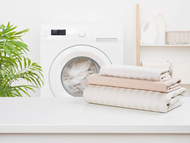Washing Your Bedding Properly—and Why Using a Laundry Additive Makes All the Difference
Jul 28th 2025
Washing your bedding isn’t just about keeping things fresh—it’s about maintaining hygiene, minimizing allergens, and extending the life of your linens. Your bed is where your body rests, sweats, and sheds skin cells for 6–8 hours every night.
If you’re not cleaning your sheets, pillowcases, duvet covers, and bed covers correctly, you’re creating a haven for bacteria, mold, dust mites, and allergens. Here’s how to do it right—and why using EC3 Laundry Additive can take your washing process to the next level.
Step 1: Check Tags and Fabric Care Labels
Before tossing anything into the washer, read the tags. You need to know two things:
- Maximum wash temperature – Hotter water kills more bacteria and helps lift oils, but not all fabrics can handle it.
- 100% Cotton or a Blend of Materials – Whether you're caring for 100% cotton or a cotton-linen blend, the key is gentle handling to preserve softness, prevent shrinkage, and maintain durability.
Understanding these guidelines helps you choose the right detergent, water temperature, and laundry additive for the job.
Step 2: Inspect and Pre-Treat
Look for stains or damage before loading up the washer. Sweat, blood, or spilled coffee can set into fabric quickly. Treating stains beforehand helps you avoid harsh wash cycles that wear down the fabric.
Blood stains? Use an enzyme-based treatment, like our EC3 Enzyme Cleaner Concentrate or a dedicated stain remover stick. If you find deep set stains, spot treat with detergent and give it at least 15 minutes to break down the residue.
Step 3: Protect Your Bedding During the Wash
For delicate items like pillow covers, consider placing them in a laundry bag. For sheets and duvet covers, turn them inside out before washing. This prevents outer fabric wear from friction and preserves the look of decorative stitching or prints.
However, if the outside is particularly soiled, leaving it exposed may be more effective for cleaning. Choose based on how dirty your bedding is.
Step 4: Load the Machine Correctly
Stuffing everything in at once might seem efficient, but overloaded machines can’t clean thoroughly. Bedding needs space to agitate properly. Group items by size and fabric thickness—wash thick duvet covers and sheets separately from delicate pillowcases.
Step 5: Add the Right Cleaning Agents
Most washing machines have three compartments:
- Pre-wash: Optional, but a good place to add our EC3 Enzyme Cleaner Concentrate for an extra cleaning boost.
- Main wash: Add your regular detergent here. For heavy loads, increase the amount.
- Fabric softener: You can skip this, as softener coats fabric with chemicals that trap odors and mold. Instead, use our EC3 Laundry Additive for the rinse cycle.
The additive is best used when you use it during the rinse cycle—not the wash cycle. If you're using a high-efficiency (HE) washer, pour 1 ounce of the additive into the rinse cycle compartment, usually where fabric softener goes.
For standard or non-HE machines, double the amount to 2 ounces in the same compartment. This additive doesn’t replace your regular detergent; instead, it's meant to work alongside it to neutralize mold spores and bacteria on fabrics.
It's especially helpful for deep-cleaning items like sheets, pillowcases, and comforters that can harbor allergens. EC3 Laundry Additive is made with natural, non-toxic ingredients and contains no synthetic fragrances or dyes, making it safe for use on all washable materials.
For extra freshness and hygiene, you can also clean your washing machine itself by adding 3 ounces of the additive into the bleach dispenser or drum and running a clean cycle.
Step 6: Choose the Right Wash Cycle
Use a “cotton” or “heavy” setting for thick linens. These cycles use more water and give the detergent and additive time to do their job. If your machine has a soil level setting, bump it up to high for bedding.
Keep the water temperature around 40°C (104°F)—hot enough to sanitize but gentle enough for most fabrics. Use a high spin speed to pull as much moisture out before drying.
Step 7: Dry the Right Way
If you have a dryer, use a medium to high heat setting for sheets and duvet covers. If you’re air drying, hang bedding outdoors where it gets direct sunlight and airflow. Sunlight is a natural disinfectant and helps freshen without chemicals.
Why Use EC3 Laundry Additive?
EC3 is a natural laundry booster that rinses away mold spores, bacteria, and lingering odors that detergent alone misses. It’s especially effective for bedding, which absorbs sweat, oil, skin cells, and mold particles every night.
Regular detergents clean visible dirt. EC3 targets what you can’t see—like mold spores and bacteria embedded deep in fabrics or lingering from humid environments. And EC3 doesn’t cover smells with fragrance—it removes what causes the smell in the first place. This is critical for people with mold allergies or chemical sensitivities.
Being Clean Isn’t Just About Looking Fresh
Washing bedding is more than routine. It’s a critical part of keeping your home’s air clean and reducing your exposure to allergens and mold. Your sheets, duvets, and pillowcases come in close contact with your skin for hours—so washing them properly is personal health care.
EC3 Laundry Additive doesn't just improve the washing process—it transforms it. If you’re recovering from mold exposure, suffer from allergies, or live in a humid climate, EC3 should be a staple in your laundry routine.
Visit Micro Balance Health Products now to make your beddings smell fresh and mold-free!



